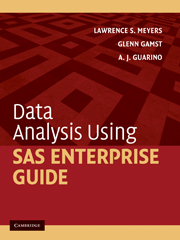Book contents
- Frontmatter
- Contents
- Preface
- Acknowledgments
- I Introducing SAS Enterprise Guide
- II Performing Analyses and Viewing Output
- III Manipulating Data
- IV Describing Data
- V Score Distribution Assumptions
- VI Correlation and Prediction
- VII Comparing Means: The t Test
- VIII Comparing Means: ANOVA
- 23 One-Way Between-Subjects ANOVA
- 24 Two-Way Between-Subjects Design
- 25 One-Way Within-Subjects ANOVA
- 26 Two-Way Mixed ANOVA Design
- IX Nonparametric Procedures
- X Advanced ANOVA Techniques
- XI Analysis of Structure
- References
- Author Index
- Subject Index
26 - Two-Way Mixed ANOVA Design
Published online by Cambridge University Press: 05 June 2012
- Frontmatter
- Contents
- Preface
- Acknowledgments
- I Introducing SAS Enterprise Guide
- II Performing Analyses and Viewing Output
- III Manipulating Data
- IV Describing Data
- V Score Distribution Assumptions
- VI Correlation and Prediction
- VII Comparing Means: The t Test
- VIII Comparing Means: ANOVA
- 23 One-Way Between-Subjects ANOVA
- 24 Two-Way Between-Subjects Design
- 25 One-Way Within-Subjects ANOVA
- 26 Two-Way Mixed ANOVA Design
- IX Nonparametric Procedures
- X Advanced ANOVA Techniques
- XI Analysis of Structure
- References
- Author Index
- Subject Index
Summary
Overview
A mixed design is one that contains at least one between-subjects independent variable and at least one within-subjects independent variable. In a simple mixed design, there are only two independent variables, one a between-subjects factor and the other a within-subjects factor; these variables are combined factorially. Because there are two independent variables, there are three effects of interest: the main effect of the between-subjects variable, the main effect of the within-subjects variable, and the two-way interaction.
The partitioning of the variance in a mixed design
The total variance of the dependent variable is partitioned into between-subjects variance and within-subjects variance. The three effects of interest are as follows.
The main effect of the between-subjects variable: The between-subjects variable is subsumed in the between-subjects portion of the variance. It has its own between-subjects error term that is used in computing its F ratio.
The main effect of the within-subjects variable: The within-subjects variable is subsumed in the within-subjects portion of the variance. It has its own within-subjects error term that is used in computing its F ratio.
The two-way interaction: The interaction effect is subsumed in the within-subjects portion of the variance. We use the within-subjects error term to compute its F ratio for this effect.
26.3 Numerical example
The following hypothetical study illustrates a 2 × 2 simple mixed design.
- Type
- Chapter
- Information
- Data Analysis Using SAS Enterprise Guide , pp. 253 - 266Publisher: Cambridge University PressPrint publication year: 2009
- 1
- Cited by



